Best bike repair stands 2025: Workstands for the pro- or home mechanic
The best bike repair stands make life considerably easier for repairs and maintenance. Whether you're looking after a race team or fettling your own fleet at home these are the best stands on the market right now
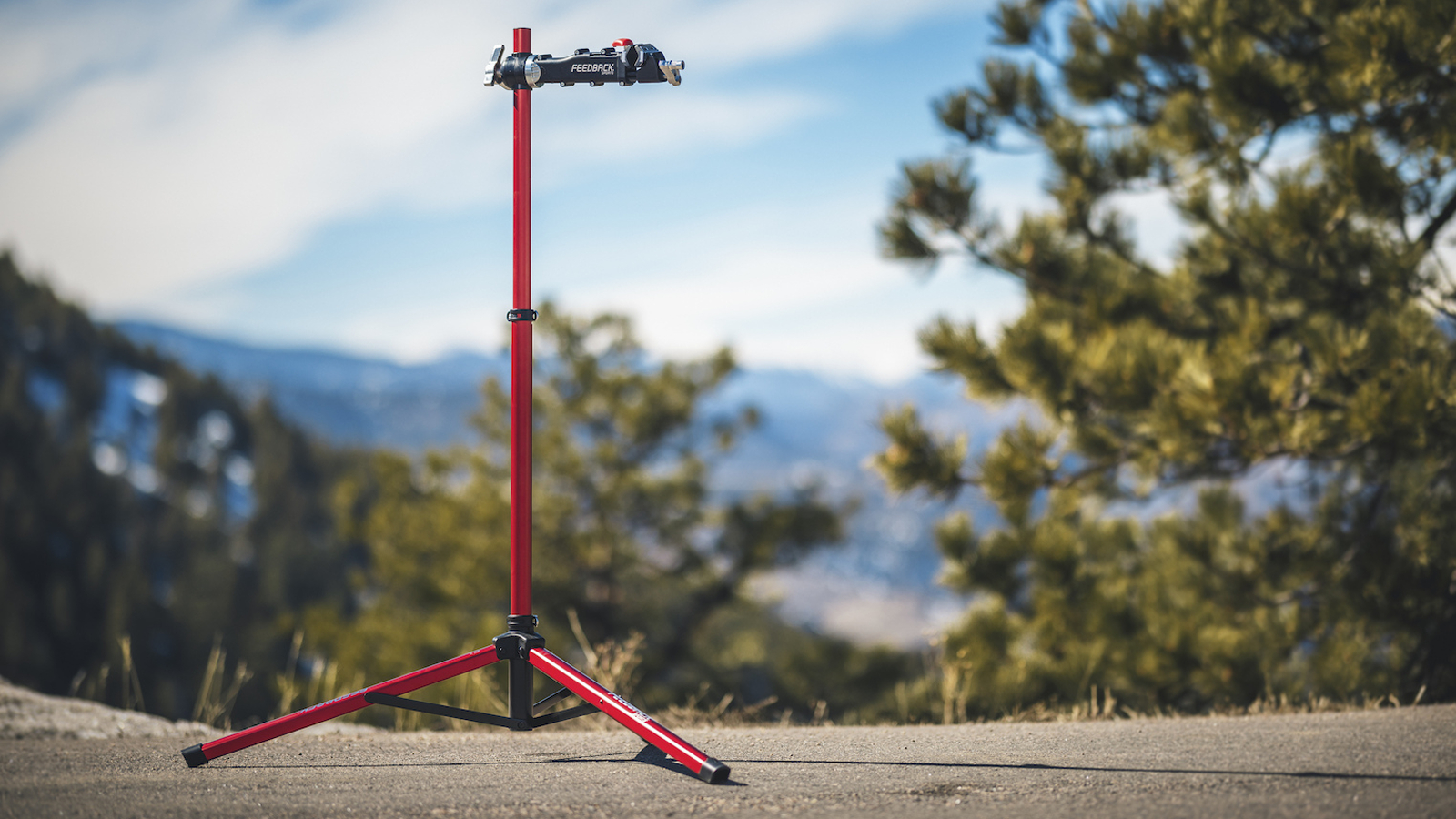
If you watch any bike race you’ll probably catch a glimpse of a few hardworking mechanics keeping the finest race machines in tip-top condition atop one of the best bike repair stands. You'll never see a mechanic working on a bike that's been flipped upside down on the floor - and neither should you.
Previously don't flip your bike upside down was one of those unwritten rules that perhaps had more of a basis in gatekeeping than anything practical, although it certainly helps avoid any damage to your saddle, bar tape and levers.
All bicycle repair stands make life easier when maintaining a bike by getting it off the floor and allowing the wheels to spin freely. The humble bike maintenance stand can take a variety of forms; some clamp the seatpost and others lock the forks into place at the dropouts. Some offer telescopic or folding legs, while others mount directly to a wall or bench to save precious workshop floor space. These differences can dramatically affect the practicality and performance so it's worth thinking about your requirements when choosing, we have listed several different types in this guide worth considering no matter what your needs are.
Whatever your chosen system, rest assured any from the following list will make your life in the workshop easier and, with some integrating tool trays and features such as weighing scales, they can also help for on-the-go tinkering, too.
Quick list
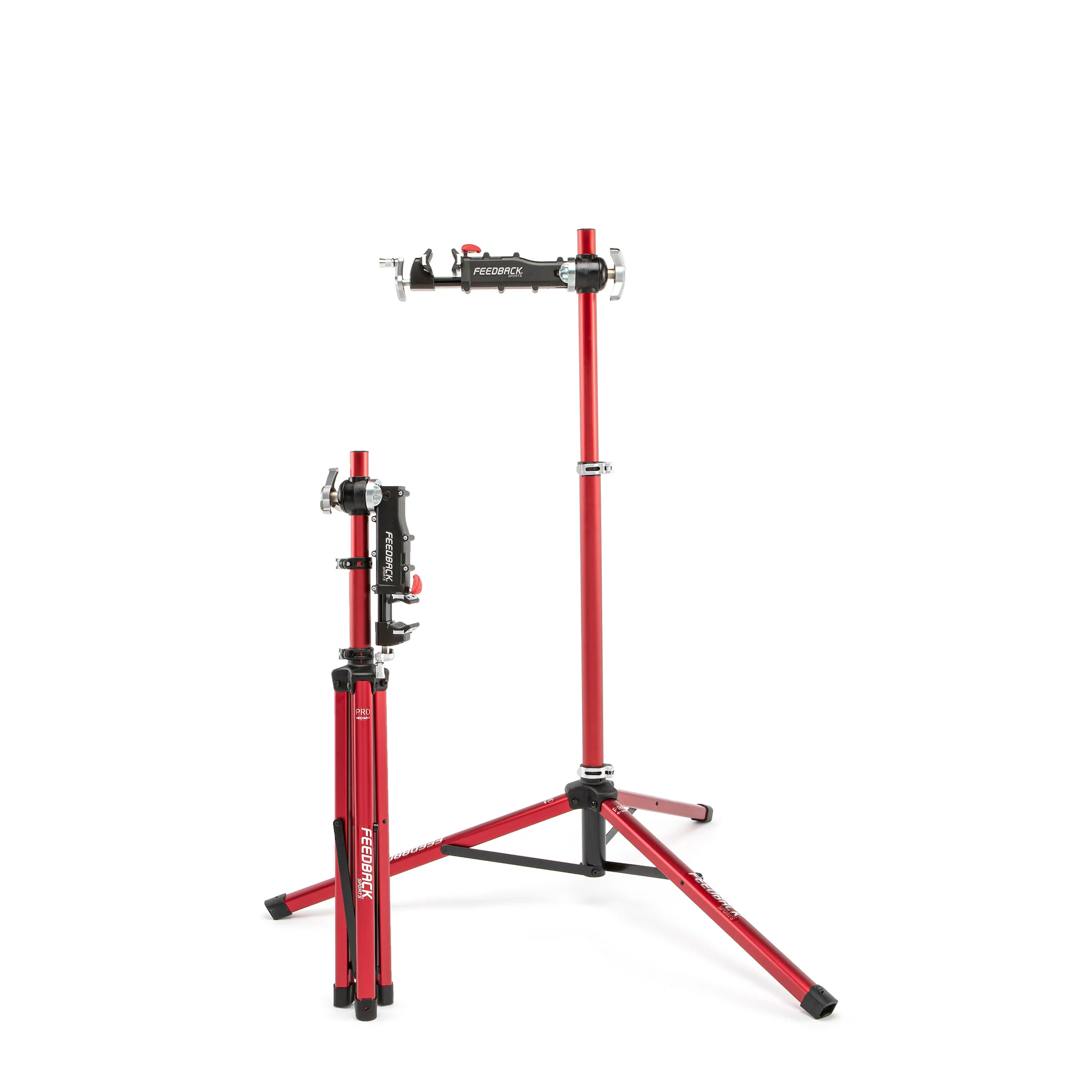
The lightweight yet sturdy design means the Pro Mechanic Bike Repair Stand caters for most mechanics' requirements.
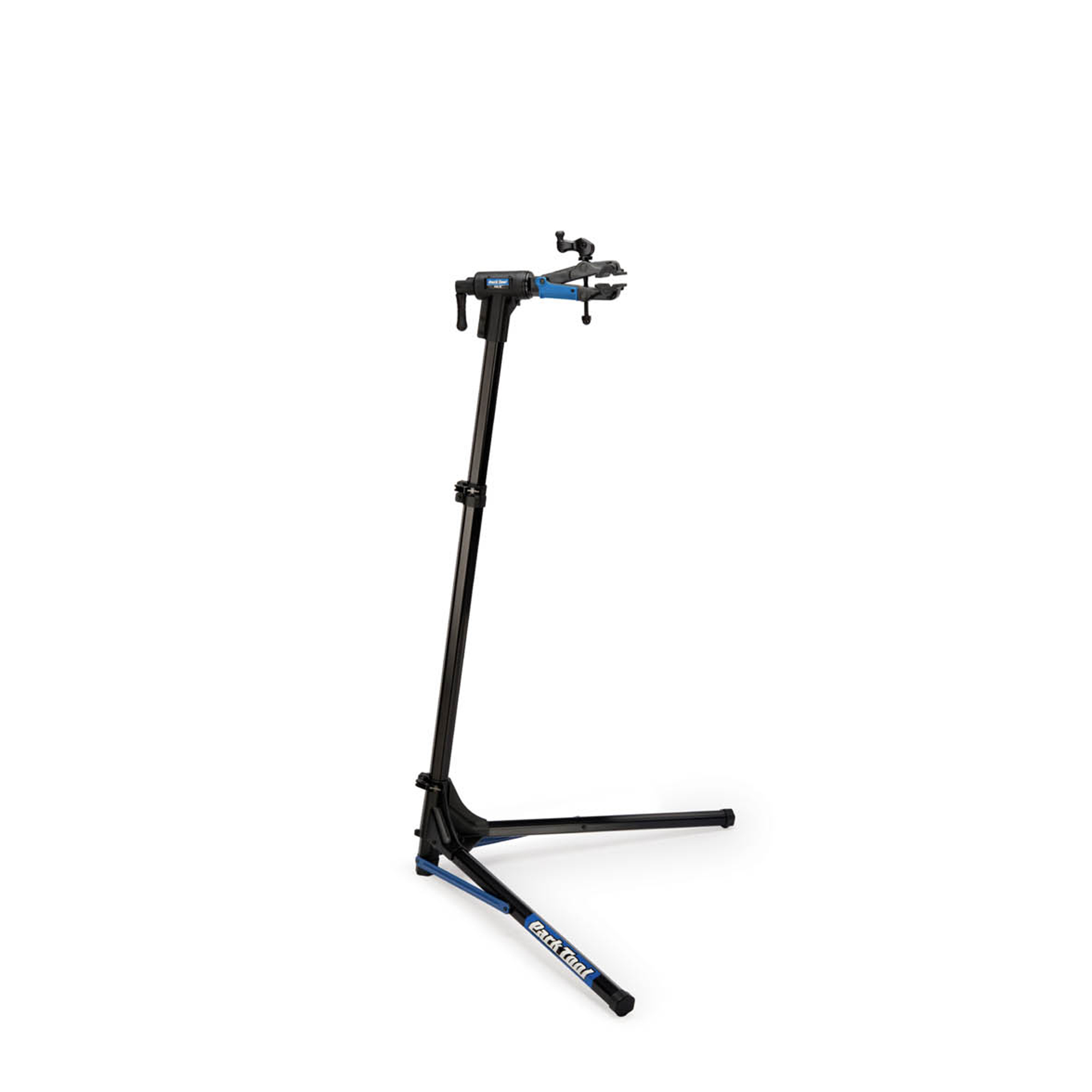
Park Tool has one of the best clamps around and pairs it with a portable design.
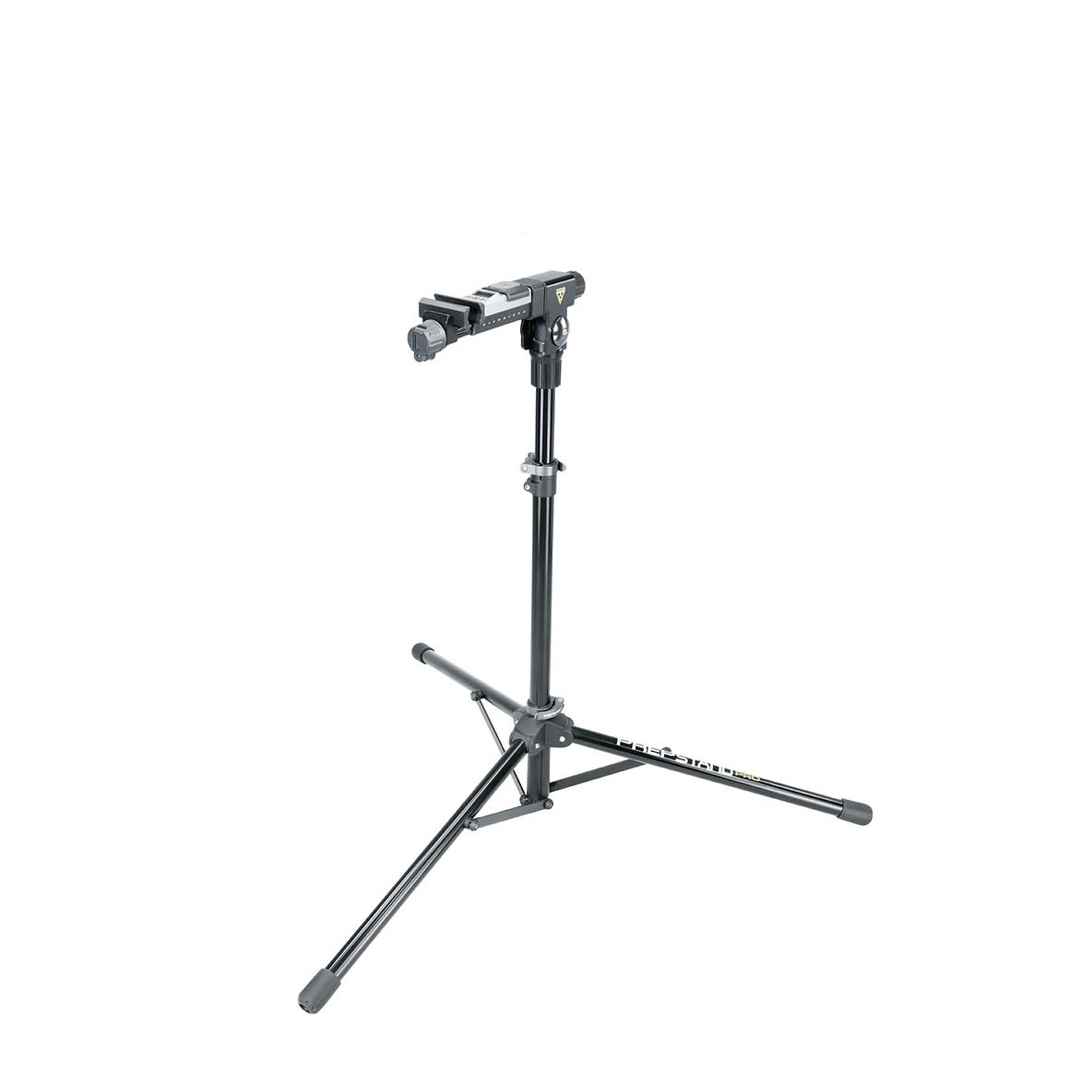
Topeak's Prepstand Pro has a built-in scale so you're inner weight weenie can easily keep track of your bike weight.
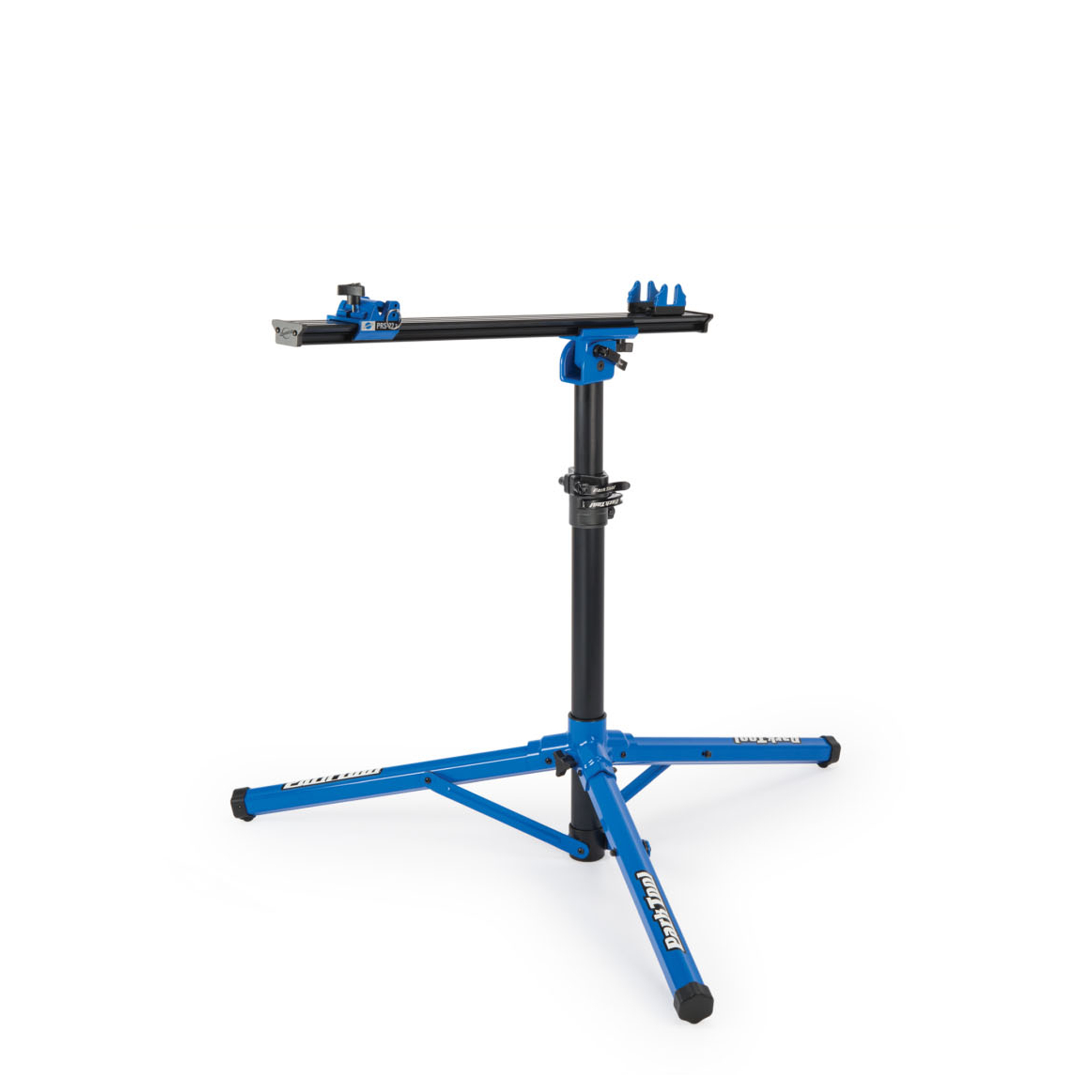
If you want a race-style axle-mounted work stand then Park Tool's PRS-22.2 Team Issue is the best option.
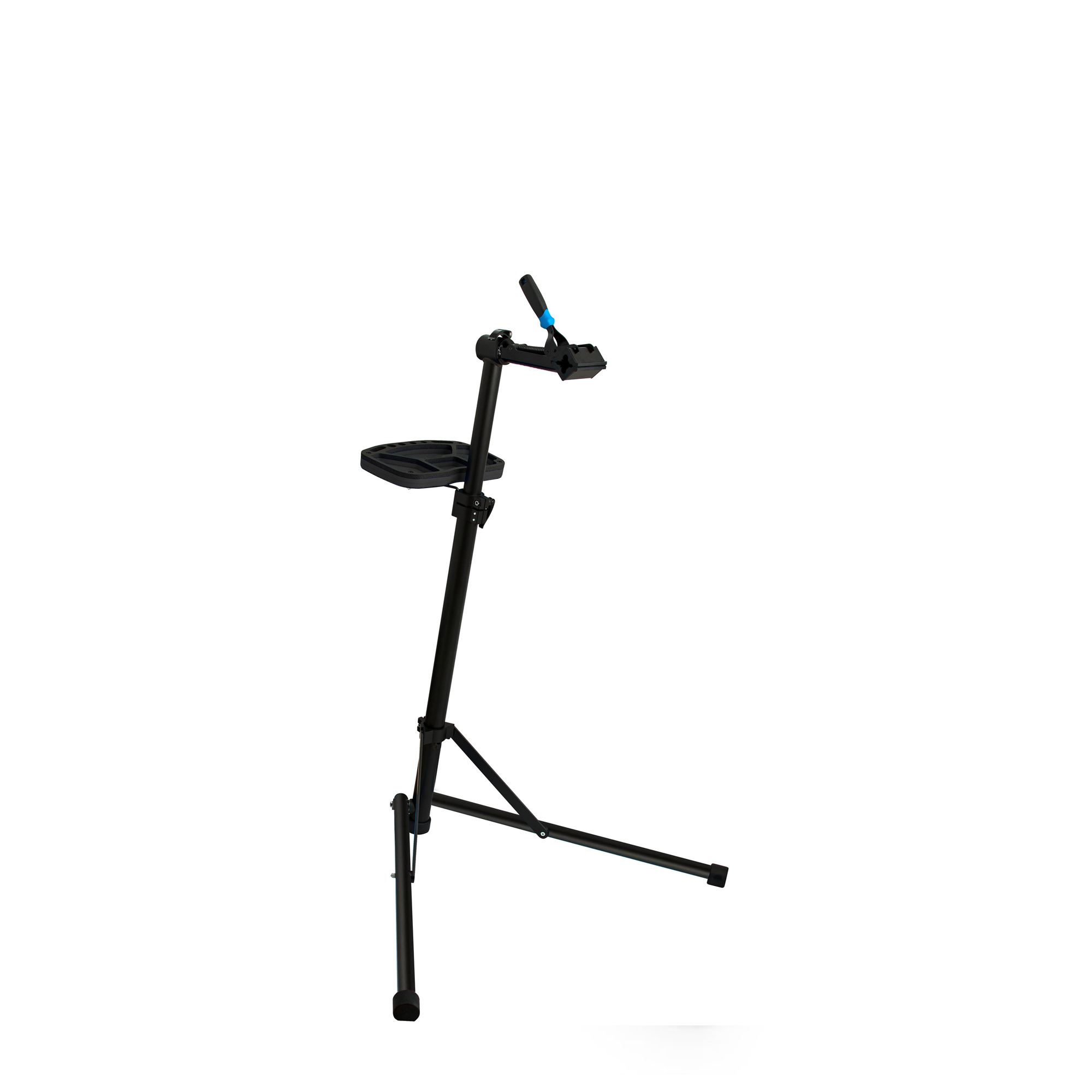
Quick clamp design and useful tool tray make quick fixes a breeze.
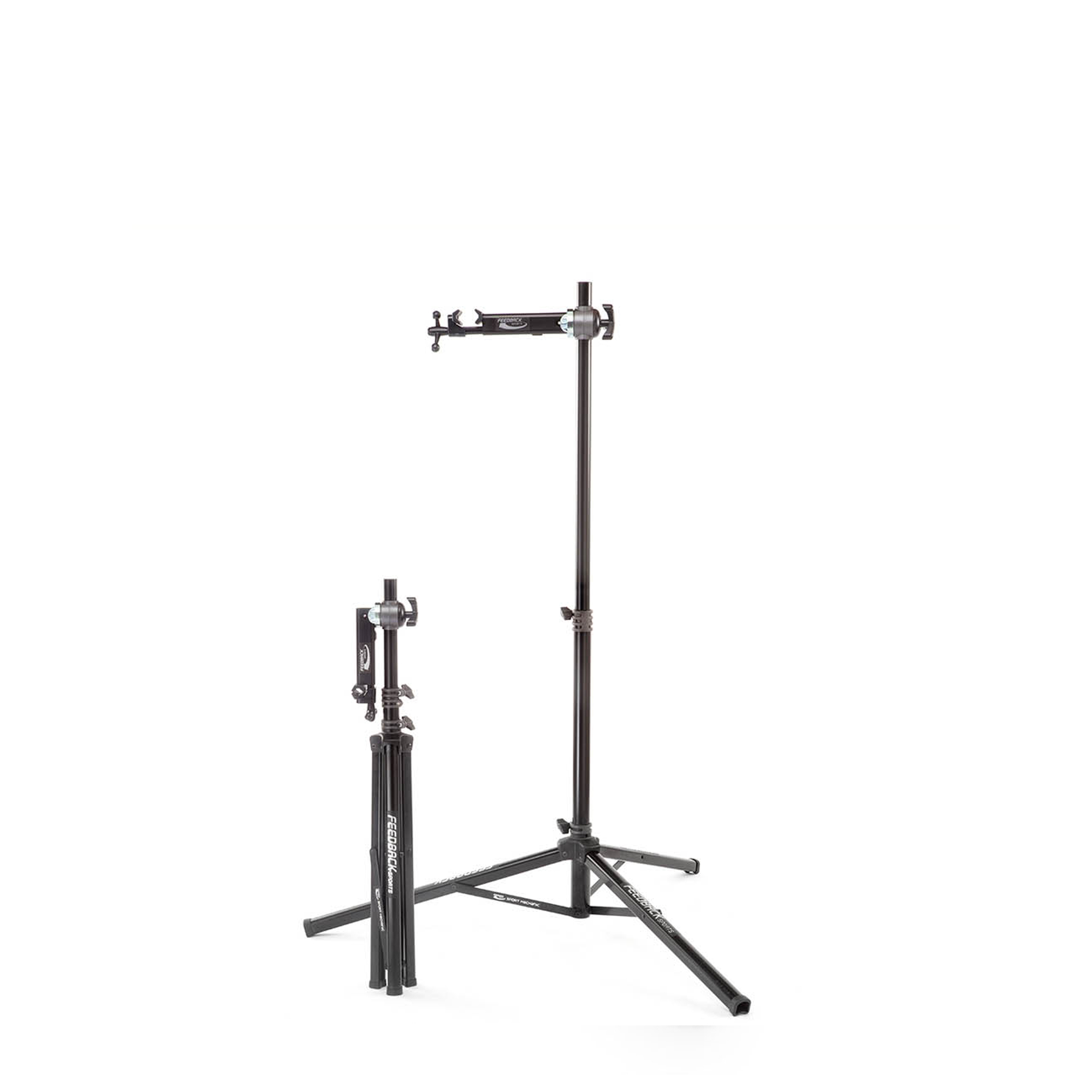
A solid and durable work stand that folds down small and doesn't break the bank.
Recent updates
Last updated on 28th of January 2025
A major overhaul of the guide to bring the guide in line with current Buyer Guide best practices, the buyer guide format has been updated to improve readability and navigation. A quick list has also been added to give readers a quick selection of products. All the products in this guide have been checked to ensure they are up-to-date, available and linked to any existing reviews.
Best bike repair stands
Best Bike Repair Stand
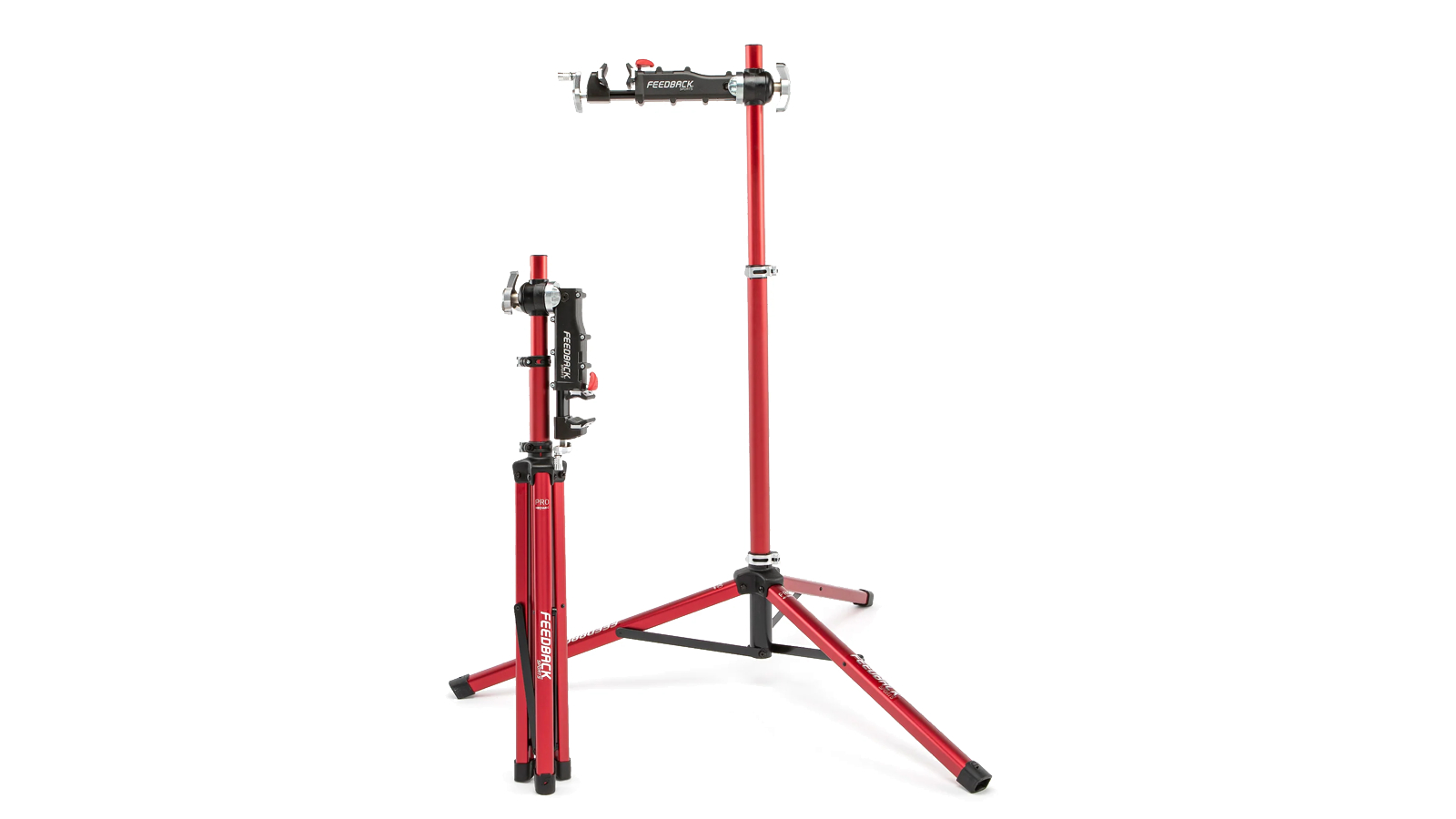
1. Feedback Pro Mechanic Bike Repair Stand
Specifications
Reasons to buy
Reasons to avoid
The Feedback Sports Pro Elite bike repair stand is lightweight, sees quality finishing and has arguably the best clamp on the market. There is a reason that, at just about any cycling event around the world, you'll find these work stands kicking around. The tubing is made from aluminium and the three-legged stance is stable even on uneven ground.
While the red anodised tubing is immediately recognisable, it's the ratcheted dial clamp that sets the Feedback Sports Pro Elite apart. With ratchet teeth placed in 5mm intervals, squeezing the jaws together with your hand will get you within one turn of the adjustment knob of the stand supporting the weight of your bike. The jaws can accommodate tubes up to 6.6cm in diameter, and when secure, the clamp can rotate through 360-degrees, so you can easily access the underside of the bike when you need to. Even better, when a repair is complete, the clamp is released with the push of a button.
The base is triangular, with each side measuring 115cm, and when fully extended it can reach 180cm tall, making it suitable for even the tallest of mechanics. There's a carry-case available, although it's sadly not included as standard.
Best for everyday use
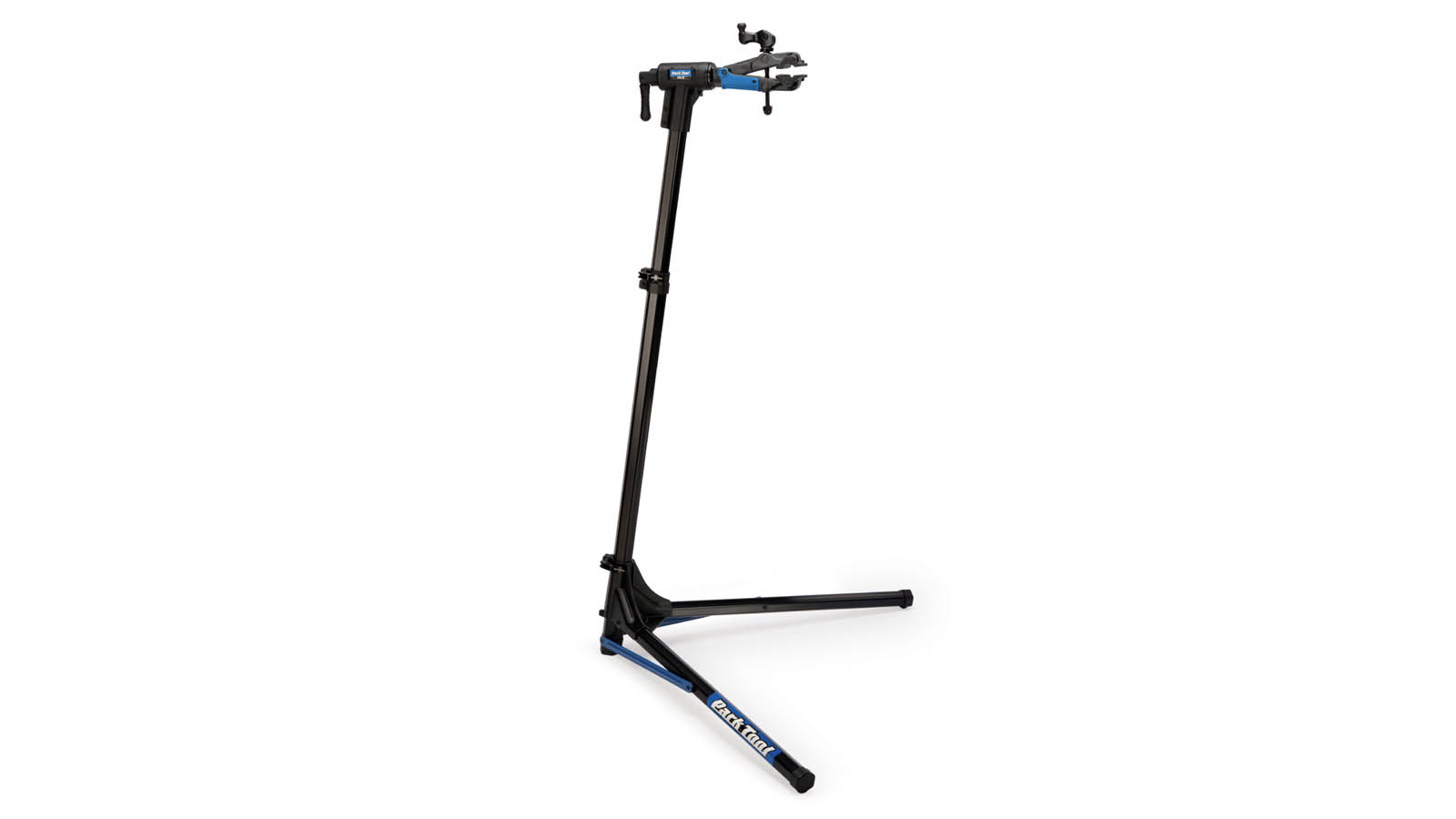
Specifications
Reasons to buy
Reasons to avoid
Even though Park Tool's Team Issue bike repair stand isn't dressed entirely in the brand's signature blue, it still gets the brand's revered build quality, which comes in a folding design and a stable three-point platform. The hex-shaped tubing is made from aluminium which keeps the weight low. It can achieve a clamping height of 152cm and offer 360-degree rotation so you can easily get in underneath the bottom bracket.
The clamp itself is cam-actuated; the lever flips like a quick release and then spins for fine adjustments. The jaws can accommodate tubes from 22mm up to 76mm and are lined with soft-touch rubber. For fast repairs, there is enough room to hang the nose of the saddle over the clamp.
It comes with a base that measures 92 x 92 x 115cm, but thanks to its two-legged fold-out construction and slightly angled vertical shaft, it manages to offer stability to rival the heavy-base shop stands.
Best for weight weenies
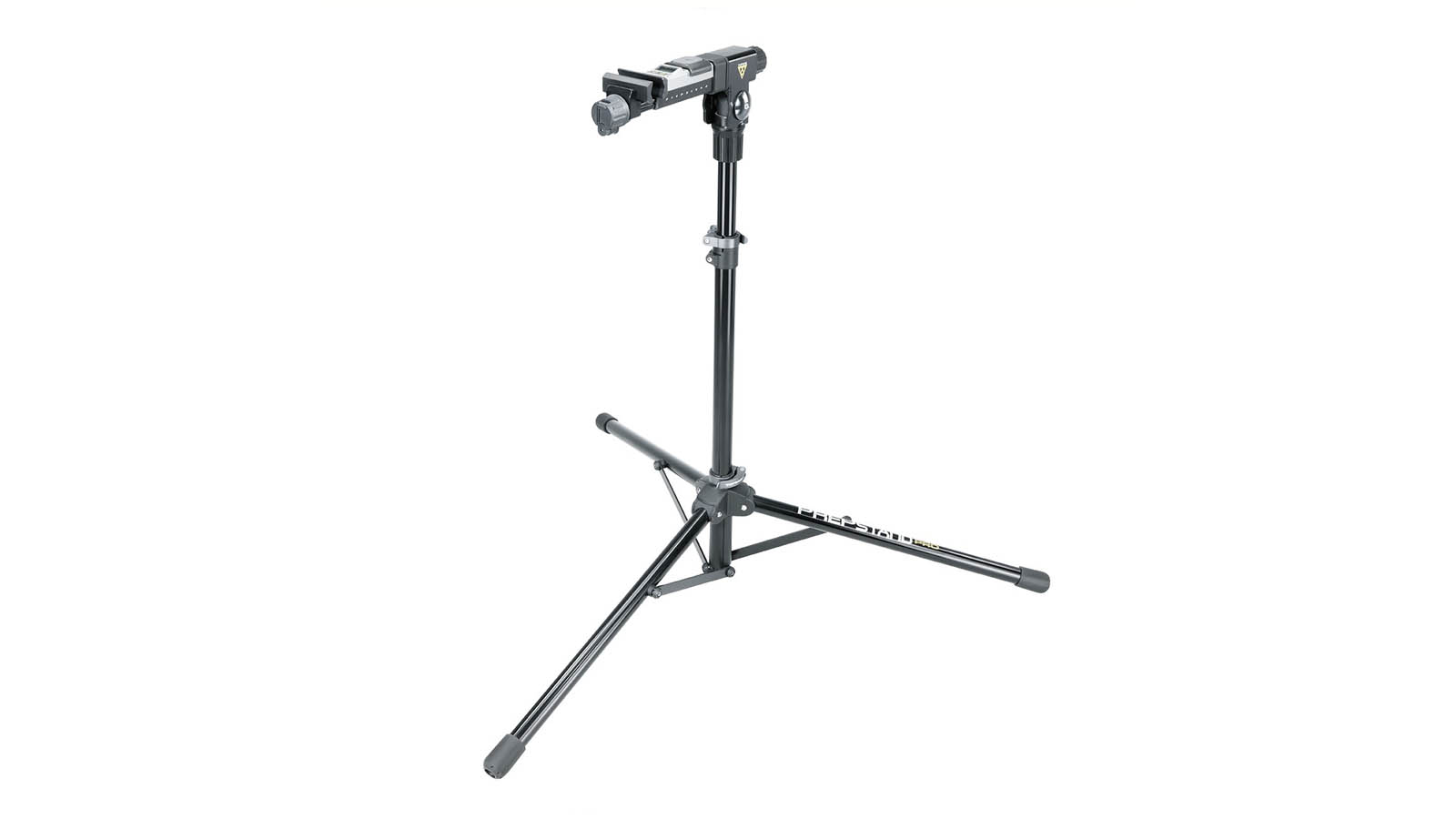
3. Topeak Prepstand Pro
Specifications
Reasons to buy
Reasons to avoid
Weight weenies rejoice, now you can have a bike repair stand and a scale in the same unit - Topeak has integrated a gram counter next to the clamp on its Prep Stand Pro.
The clamp is limited to 4.5cm, although this is still plenty enough to accommodate the width of most aero tubes, and the jaws are lined with a dense non-marking rubber. For the Prepstand Pro, Topeak added a fold-out knob to help you gain additional leverage and make quick work of tightening the jaws, but it would greatly benefit from some sort of a quick-release mechanism.
With three 71cm legs, the stand has a wide footprint and is stable on uneven ground, and it's one of the fastest to go from the carry bag to prepped and ready for a bike.
Best race-style stand
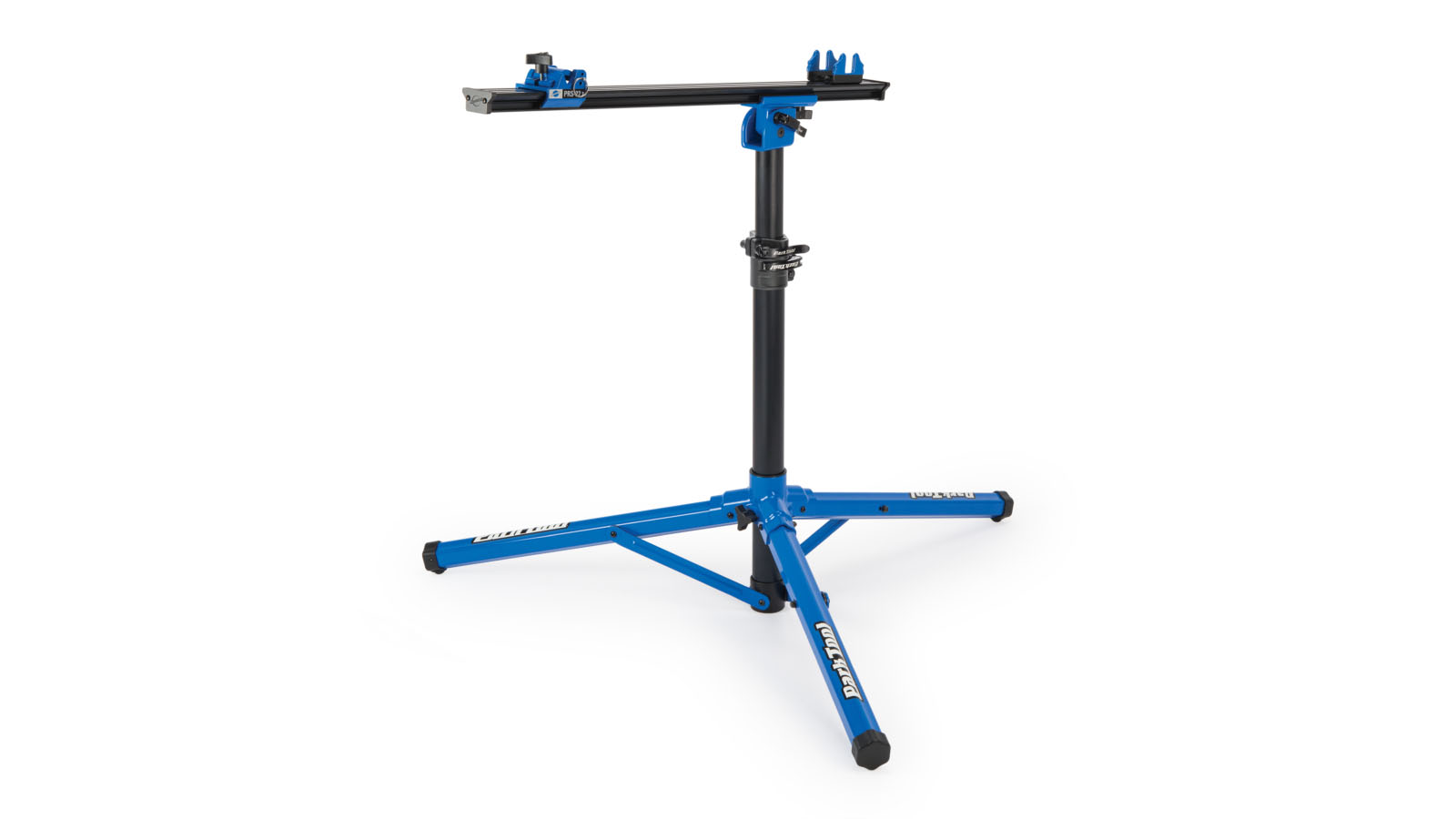
4. Park Tool PRS-22.2 Team Issue Repair Stand
Specifications
Reasons to buy
Reasons to avoid
With a sliding mount, the Park Tool PRS-22.2 Team Issue Repair Stand can hold any bike, connecting the front or rear dropouts and supporting the bottom bracket without any adaptors to keep track of - it's also the best of the bunch if you're dealing with thru-axles. The main beam is fore and aft adjustable to customise the balancing point and the bottom bracket support can be tailored to your bike's specific needs.
The Team Issue Repair stand has been updated and now spins more easily to allow access to the bike at any angle without moving your feet. At 5.65kg, it's relatively light and breaks down flatter than any other Park Tool stand.
Best for quick repairs
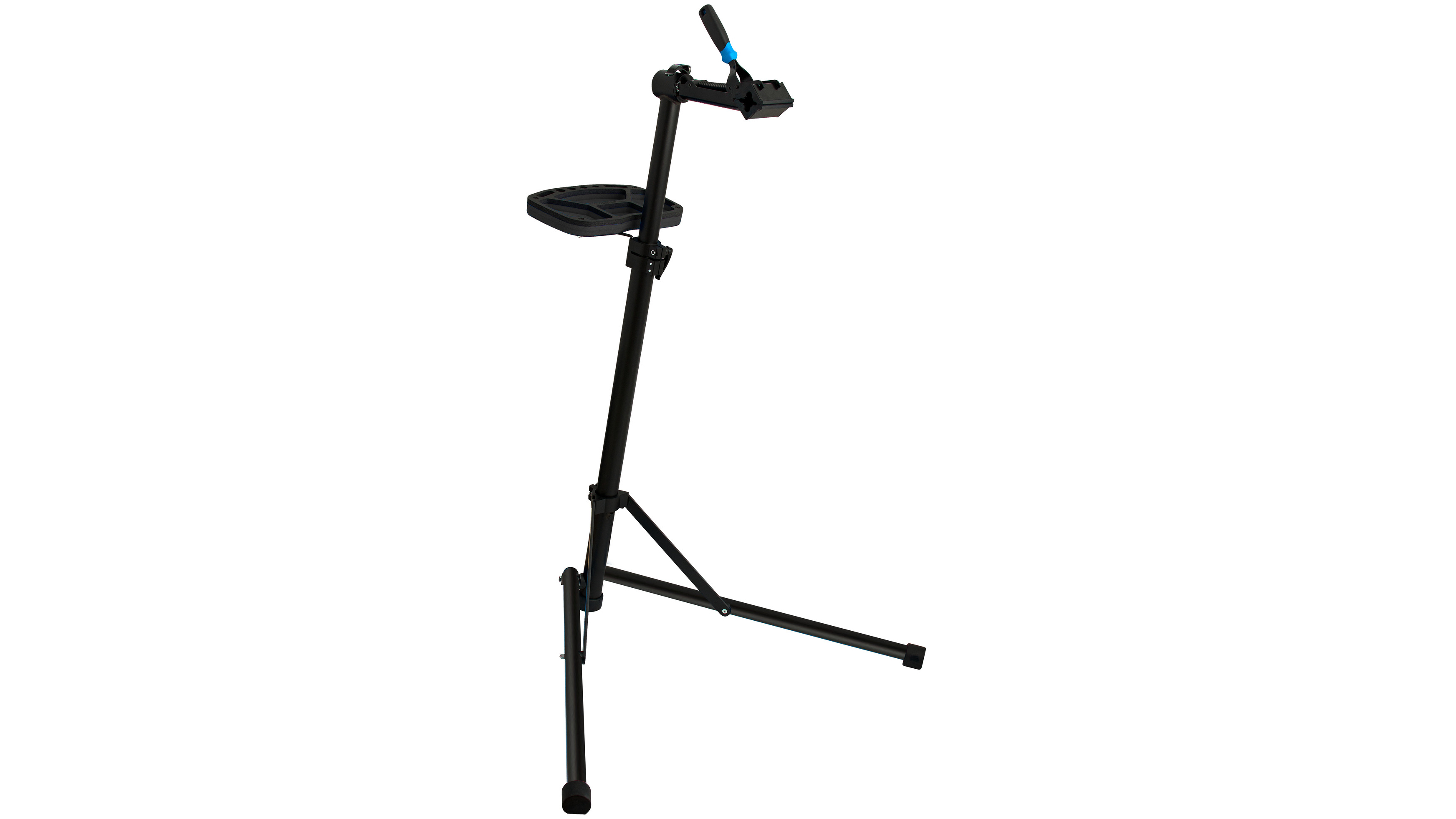
5. Unior Bikegator+
Specifications
Reasons to buy
Reasons to avoid
Unior is well known for its tools, and the Gator+ bike repair stand is fantastic if you're consistently repairing bikes with the same seat tube diameter. The clamp on the Gator+ is based on the design of a proper workshop stand with a big lever operating the jaws, however it's limited to tubes up to 32mm which will put off many mountain bikers and aero roadies.
The action is smooth, but you'll need to adjust the clamping tension before you're trying to balance a bike in one hand and spin the threaded adjuster rod with the other - a spring-loaded version of the clamp is also available. The jaws are lined with rubber, so there is no need to insulate your frame with a rag.
Our favourite thing about the Bike Gator + is the included foam tray with a divided top and slots for tools; it's a luxury that requires an additional purchase with most stands.
The entire stand, including the clamp, is made from steel, so it's not completely immune to rusting, but it manages to remain lightweight.
Best value
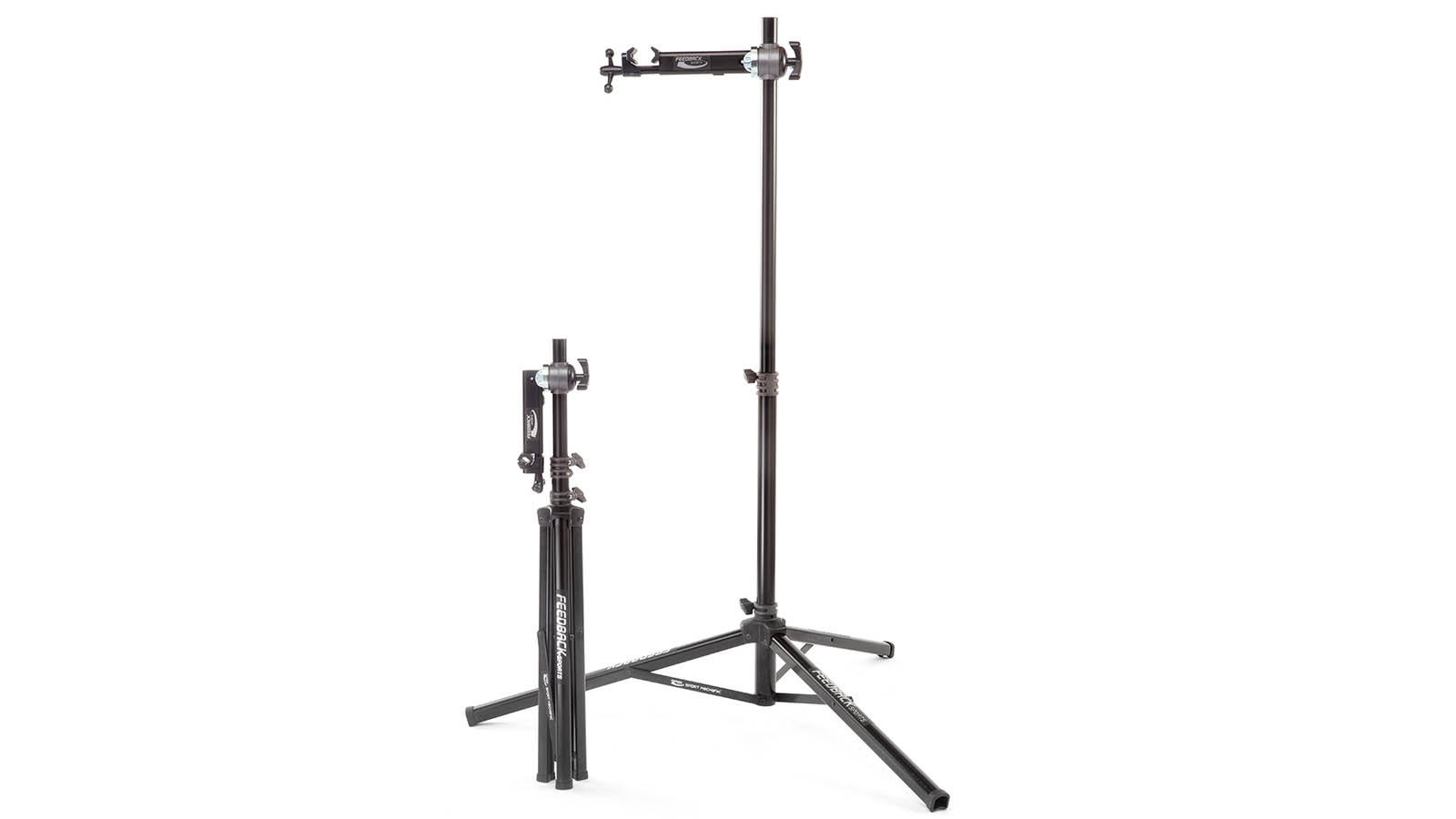
6. Feedback Sports Sport Mechanic
Specifications
Reasons to buy
Reasons to avoid
The Feedback Sports Sport Mechanic stand comes with a lighter price tag than its red anodised sibling and with the cost-saving, misses out on the nifty quick-release ratcheting clamp, yet it's still a stable, lightweight and portable bike repair stand.
The clamp is still lined with grippy rubber, but to grab your bike's seatpost, you'll have to spin the lever on the clamp until it's tight enough to support the weight of your bike. Despite the max weight being 29kg in comparison to the Pro Elite Stand's 39kg, with anything except an electric mountain bike, it's no less stable as you try to loosen bottom-bracket bearings or stuck pedals.
The Sport Mechanic compacts down just as small as the rest of Feedback's stands and it's still lightweight despite the lower price point.
Best for travelling
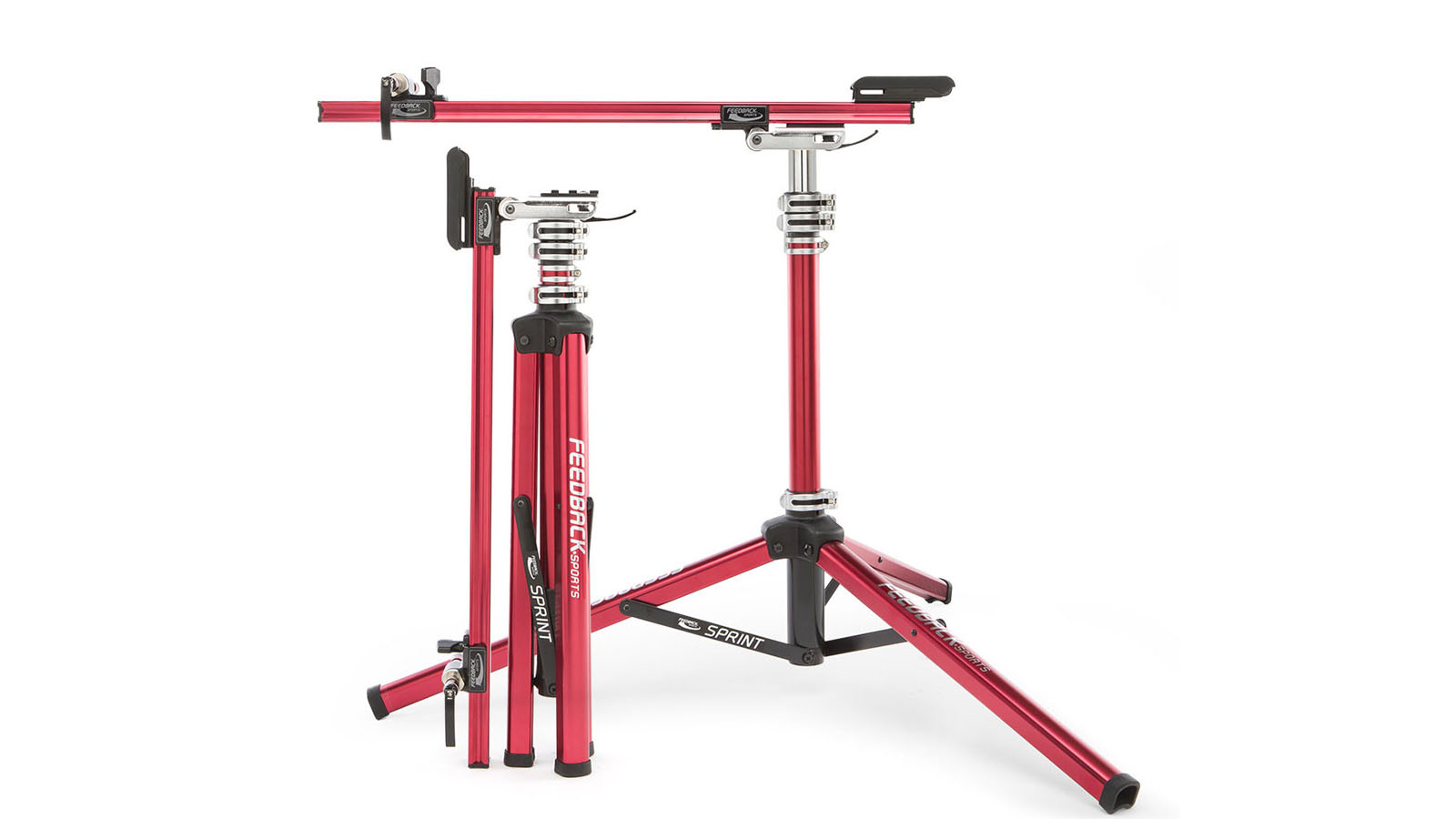
7. Feedback Sports Sprint
Specifications
Reasons to buy
Reasons to avoid
Made with Feedback Sports' eye-catching red anodised tubing, the Sprint Repair stand works with every modern axle spacing and standard except for Super Boost and can grab onto bikes at the front or rear.
Weighing 5.7kg, the Sprint Stand is lightweight yet strong enough to support bikes up to 39kg in weight. The tripod-style legs are stable even on uneven ground and the rotating platform allows you to spin the bike around with the flick of your wrist.
The bottom bracket is supported by plush 12cm rubber-covered metal strips with a cut-out to allow cable routing and the like to pass through unobstructed.
The 360 degree rotation means you can stay put whilst accessing every angle of the bike while wrenching or cleaning, and to top it off, Feedback Sports also makes a range of extras from tool trays to bottle openers that attach to the centre column.
Best for heavy bikes
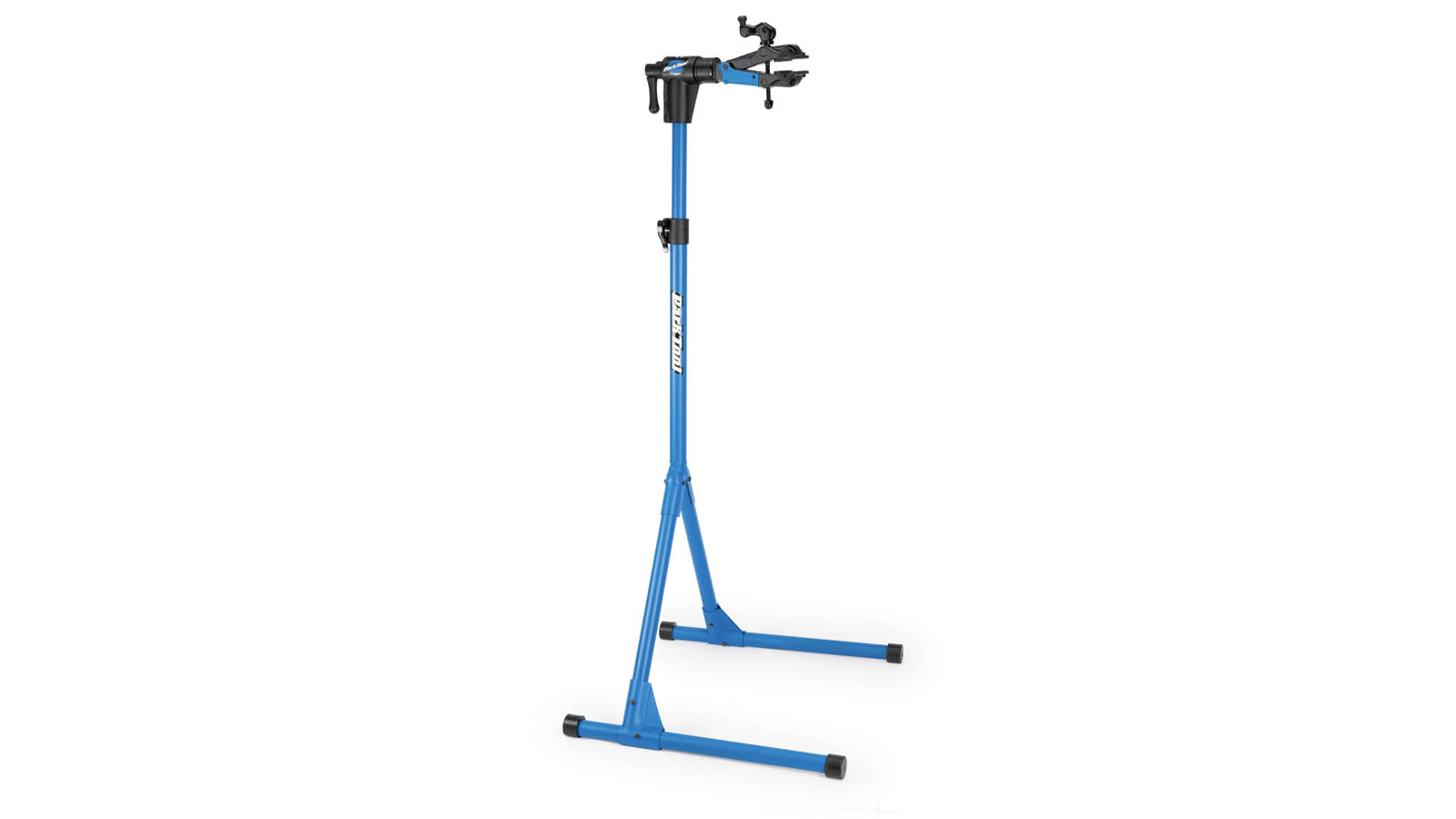
8. Park Tool PCS 4-2 Deluxe Home Mechanic Repair Stand
Specifications
Reasons to buy
Reasons to avoid
With a four-point leg system, the Park Tool Deluxe stand is ideal for home use. It's available with two different clamps; one with an adjustable linkage and a micro-adjust cam clamp. Both of these are top-end, shop-level clamps meaning the bike can be adjusted at any angle and the jaw protectors are replaceable and readily available.
The legs are made from powder-coated steel tubing and are a bit wobbly on uneven ground. When you lift the stand up the legs collapse flat meaning the work stand can be tucked into a corner or down the side of a cabinet or closet, but it's far from the most portable option on this list.
How to choose the best bike repair stand for you
Not sure what features you really need, or whether you're after a clamp or race-style stand? Scroll down and read on and we'll guide you through any questions you might have.
What are they key features I should look for in a bike stand?
Spoiler alert: The colour isn't really top priority here
Clamp adjustment
Given that bikes come in a variety of geometries it stands to reason that having a clamp with angle adjustment is paramount to keep your bike level, or to place it in the optimum position for jobs like bleeding brake hoses.
Furthermore jaw aperture adjustment should be a priority given the variety of tube diameters on the market today.
Quick release
Getting your bike in and out of any stand should be quick and easy, rather than laborious and frustrating. Having a stand with a quick release clamp speeds things up no end.
Height adjustment
Back health is important, and so having a stand you can set to the optimum height for your body is important to allow you to work in comfort.
Capacity
A lightweight bike stand may sound excellent on paper, but if you own a steel tandem you don't want it collapsing under the load. Make sure the maximum capacity isn't going to be exceeded by any of your bikes before you spend your hard earned money.
Jaw protection
Hard plastic jaws can lead to scratches; look for jaws with tacky rubber to reduce clamping forces.
Do I need a clamp or race-style bike stand?
Both systems have their own pros and cons, so lets see which one is right for you.
Race-style bike repair stands
If you've a particularly delicate fleet of bicycles (think high end carbon or ultra-thin steel) then this will likely be the system for you. They are usually come in a little higher in the price range but also tend to offer more features. Most importantly, given that they operate by cradling the bottom bracket and clamping the forks at the dropouts they don't put any unwanted stresses on your seatpost or any of the frame tubes themselves.
Many offer the ability to spin on a central axis, meaning you can access the whole bike without really having to move yourself. Naturally to make the most of this you'll need to keep the stand in a relatively central location, making them more suitable for larger workshops and commercial shop floors.
One thing to note is that if you're blessed with a variety of bikes you will need to make sure all your axle standards are accommodated, and given that mountain bike wheelbases have been getting stratospheric in recent years, that it's long enough to fit your off road machine comfortably.
Clamp-style bike repair stands
More common and usually cheaper, these are often a riders first point of entry into a life of constant bicycle maintenance.
One thing that cannot be stressed enough is that wherever possible you should always clamp to the seatpost, rather than the frame itself. You really want to avoid any accidentally dented or cracked tubing. If you do have to clamp the frame, do so gently, and pad the jaws with a rag or some old inner tubes to reduce the forces and increase grip.
If you've got a wide range of bikes to work on this system is probably a better option for you, given that the clamp is universal. Also given that wall-mounted options are available, if you're operating in a confined space then this may save you some valuable real estate.
Does my bike stand need to fold away?
Hitting the road? Then portability considerations should be on your list.
The best bikestand in the world will be useless if you have nowhere to put it. If you're blessed with a giant workshop with acres of floorspace and no need to pack things away ever then feel free to skim this bit, but those of us with crowded garages, cluttered shop floors, or those who have to awkwardly wheel a bike into the kitchen to sort out a creaky bottom bracket then the physical size and weight of a stand is a key consideration.
A clamp mounted to the wall is obviously the most compact system, but this isn't right for everyone. Nothing spoils the feng shui of a recently refurbished kitchen like a set of jaws sticking out of the wall.
Be realistic with what you're after; does it need to pack away when you're done? If so, where is it going to be stored? Are you taking it on the road? If so, do you really want to lug something massive up to a 6th floor apartment, or would you be better off with a lighter stand with fewer features?
In our experience, outside of commercial settings, folding stands work best for the majority of consumers and are usually plenty stable enough to work on a variety of surfaces.
What should I look for in a clamp?
Clamps are unfortunately not created equal.
If you opt for a clamp-style bike stand the the clamp itself is really the heart of the system. The best clamps will grip well without needed excessive force.
it's worth reiterating again that you should always clamp the seat post wherever possible, but for a quick fix you can get away with simply resting the toptube into the lower jaw and let gravity hold it in place.
ideally the jaws will be lined with soft rubber. Not only does this avoid scratching your pride and joy, but it also increases the purchase for a given clamping force, making things more suitable for delicate tubing should you have to clamp the frame.
most of the bike stands listed above will have daws with some degree of fine adjustment, which also helps to keep things safe.
If your stand has hard plastic jaws then line with a soft cloth, or wrap the jaws in old inner tubes to achieve the same effect.
Can I clamp my dropper post?
Opinion is, unfortunately, split on this key issue.
As dropper posts become more common this will be an ever more regular conundrum. Advice varies between different manufacturers, so that should be your first port of call. If you're running different bikes, all with dropper posts, then you may be better off with a race-style bike stand to avoid any potential issues.
Are you working on uneven ground?
Take care to avoid things toppling over
Indoors, on a smooth surface, most bike stands will be perfectly stable enough to operate with. If you're a budding cyclocross mechanic, or need to do repairs roadside then look for something with telescopic legs to account for any slope, rubber feet for grip, and a wide base to increase stability.
How do we test?
Bike repair stands only need to perform one job, hold the bike securely when performing bike maintenance. However, this is easier said than done and it's often the small details that make or break the performance of a repair stand.
The first thing to consider is portability, if a repair stand is designed to be folded away and transported we take note of pack-down sizes and evaluate how easy it is to assemble and fold away. Once set up we measure the footprint and asses leg format and stability.
The repair stands are tested with different styles of bikes to determine how well they hold a range of bikes from aero road bike tubes to heavier gravel bikes and mountain bikes. Full testing revolves around performing maintenance tasks on a bike to establish how the stand performs when working on a bike, highlighting positive or negative features.
Testing is the backbone of the tech department at Cyclingnews and how we test is taken seriously, so read on to find out more.
Get The Leadout Newsletter
The latest race content, interviews, features, reviews and expert buying guides, direct to your inbox!
Based on the Gold Coast of Australia, Colin has written tech content for cycling publication for a decade. With hundreds of buyer's guides, reviews and how-tos published in Bike Radar, Cyclingnews, Bike Perfect and Cycling Weekly, as well as in numerous publications dedicated to his other passion, skiing.
Colin was a key contributor to Cyclingnews between 2019 and 2021, during which time he helped build the site's tech coverage from the ground up. Nowadays he works full-time as the news and content editor of Flow MTB magazine.